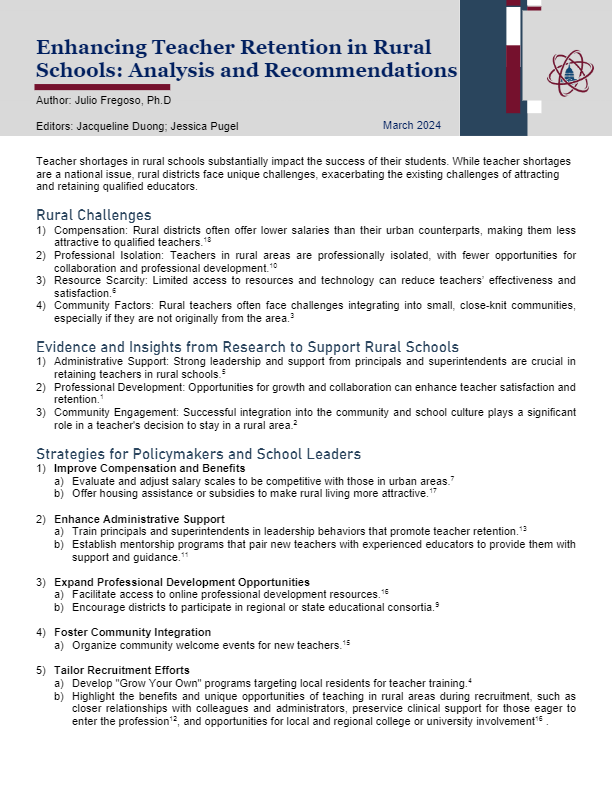
Teacher shortages in rural schools substantially impact the success of their students. While teacher shortages are a national issue, rural districts face unique challenges, exacerbating the existing challenges of attracting and retaining qualified educators.
Rural Challenges
- Compensation: Rural districts often offer lower salaries than their urban counterparts, making them less attractive to qualified teachers. (18)
- Professional Isolation: Teachers in rural areas are professionally isolated, with fewer opportunities for collaboration and professional development. (10)
- Resource Scarcity: Limited access to resources and technology can reduce teachers’ effectiveness and satisfaction. (6)
- Community Factors: Rural teachers often face challenges integrating into small, close-knit communities, especially if they are not originally from the area. (3)
Evidence and Insights from Research to Support Rural Schools
- Administrative Support: Strong leadership and support from principals and superintendents are crucial in retaining teachers in rural schools. (5)
- Professional Development: Opportunities for growth and collaboration can enhance teacher satisfaction and retention. (1)
- Community Engagement: Successful integration into the community and school culture plays a significant role in a teacher’s decision to stay in a rural area. (2)
Strategies for Policymakers and School Leaders
- Improve Compensation and Benefits
- Evaluate and adjust salary scales to be competitive with those in urban areas. (7)
- Offer housing assistance or subsidies to make rural living more attractive. (17)
- Enhance Administrative Support
- Train principals and superintendents in leadership behaviors that promote teacher retention. (13)
- Establish mentorship programs that pair new teachers with experienced educators to provide them with support and guidance. (11)
- Expand Professional Development Opportunities
- Facilitate access to online professional development resources. (16)
- Encourage districts to participate in regional or state educational consortia. (9)
- Foster Community Integration
- Organize community welcome events for new teachers. (15)
- Tailor Recruitment Efforts
- Develop “Grow Your Own” programs targeting local residents for teacher training. (4)
- Highlight the benefits and unique opportunities of teaching in rural areas during recruitment, such as closer relationships with colleagues and administrators, preservice clinical support for those eager to enter the profession (12), and opportunities for local and regional college or university involvement. (16)
Additional Resources and References
- Azano, A. P., & Stewart, T. T. (2015). Exploring Place and Practicing Justice: Preparing Pre-Service Teachers for Success in Rural Schools. Journal of Research in Rural Education.
- Carver-Thomas, D., & Darling-Hammond, L. (2017). Teacher Turnover: Why It Matters and What We Can Do About It. Learning Policy Institute.
- Chandler, R. (2014). Teachers’ Beliefs about Poverty and the Impact on Learning Disabilities Identification in a Poor, Rural School District. The Rural Educator, 35(3).
- Carver-Thomas, D., Darling-Hammond, L., & Podolsky, A. (2019). Trouble with Teacher Turnover: How Teacher Attrition Affects Students and Schools. Education Policy Analysis Archives, 27(36).
- Ferri, F., Grifoni, P., & Guzzo, T. (2020). Online Learning and Emergency Remote Teaching: Opportunities and Challenges in Emergency Situations. Societies, 10(4), 86.
- Cui, M., Xia, Y., & Wang, C. (2022). Does community matter?: a study on rural Chinese teachers’ turnover. Teachers and Teaching, 28(3), 263–283.
- Hudson, P., & Hudson, S. (2008). Changing Preservice Teachers’ Attitudes for Teaching in Rural Schools. Australian Journal of Teacher Education, 33(4), 67–77.
- Gehrke, R. S., & McCoy, K. (2007). Considering the Context: Differences between the Environments of Beginning Special Educators Who Stay and Those Who Leave.
- Hoeft, T. J., Fortney, J. C., Patel, V., & Unützer, J. (2018). Task-Sharing Approaches to Improve Mental Health Care in Rural and Other Low-Resource Settings: A Systematic Review. The Journal of Rural Health, 34(1), 48–62. https://doi.org/10.1111/jrh.12229
- Johnson, J., Showalter, D., Klein, R., & Lester, C. (2014). Why Rural Matters 2013-2014: The Condition of Rural Education in the 50 States. Rural School and Community Trust.
- Monk, D. H. (2007). Recruiting and Retaining High-Quality Teachers in Rural Areas. The Future of Children, 17(1), 155–174. https://doi.org/10.1353/foc.2007.0009
- Podolsky, A., Kini, T., Bishop, J., & Darling-Hammond, L. (2016). Solving the Teacher Shortage: How to Attract and Retain Excellent Educators. Learning Policy Institute.
- Sutcher, L., Darling-Hammond, L., & Carver-Thomas, D. (2016). A Coming Crisis in Teaching? Teacher Supply, Demand, and Shortages in the U.S. Learning Policy Institute.
- Thier, M., Longhurst, J. M., Grant, P., & Hocking, J. E. (2021). Research Deserts: A Systematic Mapping Review of U.S. Rural Education Definitions and Geographies. Journal of Research in Rural Education. https://eds.p.ebscohost.com/abstract
- Towse, P., Kent, D., Osaki, F., & Kirua, N. (2002). Non-graduate Teacher Recruitment and Retention: Some Factors Affecting Teacher Effectiveness in Tanzania. Teaching and Teacher Education, 18(6), 637–652. https://doi.org/10.1016/S0742-051X(02)00024-0
- Versland, T., Will, K., Lux, N., & Hicks, J. (2020). Envisioning the Rural Practicum: A Means to Positively Affect Recruitment and Retention in Rural Schools. Theory & Practice in Rural Education, 10(1), 103–118. https://doi.org/10.3776/TPRE.2020.V10N1P103-118
- Zolkoski, S. M., Aguilera, S. E., West, E. M., Miller, G. J., Holm, J. M., Sass, S. M., & Stocks, E. L. (2021). Teacher Perceptions of Skills, Knowledge, and Resources Needed to Promote Social and Emotional Learning in Rural Classrooms. The Rural Educator, 41(3).
- Carver-Thomas, D., Darling-Hammond, L., & Podolsky, A. (2019). The Trouble with Teacher Turnover: How Teacher Attrition Affects Students and Schools. Education Policy Analysis Archives, 27(36). https://doi.org/10.14507/epaa.27.3699
The Research-to-Policy Collaboration (RPC) works to bring together research professionals and public officials to support evidence-based policy. Please visit their website to learn more.
Key Information
RPC Website
Research-to-Policy Collaboration
Publication DateMarch 7, 2024
Topic Area(s)Education and Child Development
Resource TypeWritten Briefs
Share This Page
Teacher shortages in rural schools substantially impact the success of their students. While teacher shortages are a national issue, rural districts face unique challenges, exacerbating the existing challenges of attracting and retaining qualified educators.
Rural Challenges
- Compensation: Rural districts often offer lower salaries than their urban counterparts, making them less attractive to qualified teachers. (18)
- Professional Isolation: Teachers in rural areas are professionally isolated, with fewer opportunities for collaboration and professional development. (10)
- Resource Scarcity: Limited access to resources and technology can reduce teachers’ effectiveness and satisfaction. (6)
- Community Factors: Rural teachers often face challenges integrating into small, close-knit communities, especially if they are not originally from the area. (3)
Evidence and Insights from Research to Support Rural Schools
- Administrative Support: Strong leadership and support from principals and superintendents are crucial in retaining teachers in rural schools. (5)
- Professional Development: Opportunities for growth and collaboration can enhance teacher satisfaction and retention. (1)
- Community Engagement: Successful integration into the community and school culture plays a significant role in a teacher’s decision to stay in a rural area. (2)
Strategies for Policymakers and School Leaders
- Improve Compensation and Benefits
- Evaluate and adjust salary scales to be competitive with those in urban areas. (7)
- Offer housing assistance or subsidies to make rural living more attractive. (17)
- Enhance Administrative Support
- Train principals and superintendents in leadership behaviors that promote teacher retention. (13)
- Establish mentorship programs that pair new teachers with experienced educators to provide them with support and guidance. (11)
- Expand Professional Development Opportunities
- Facilitate access to online professional development resources. (16)
- Encourage districts to participate in regional or state educational consortia. (9)
- Foster Community Integration
- Organize community welcome events for new teachers. (15)
- Tailor Recruitment Efforts
- Develop “Grow Your Own” programs targeting local residents for teacher training. (4)
- Highlight the benefits and unique opportunities of teaching in rural areas during recruitment, such as closer relationships with colleagues and administrators, preservice clinical support for those eager to enter the profession (12), and opportunities for local and regional college or university involvement. (16)
Additional Resources and References
- Azano, A. P., & Stewart, T. T. (2015). Exploring Place and Practicing Justice: Preparing Pre-Service Teachers for Success in Rural Schools. Journal of Research in Rural Education.
- Carver-Thomas, D., & Darling-Hammond, L. (2017). Teacher Turnover: Why It Matters and What We Can Do About It. Learning Policy Institute.
- Chandler, R. (2014). Teachers’ Beliefs about Poverty and the Impact on Learning Disabilities Identification in a Poor, Rural School District. The Rural Educator, 35(3).
- Carver-Thomas, D., Darling-Hammond, L., & Podolsky, A. (2019). Trouble with Teacher Turnover: How Teacher Attrition Affects Students and Schools. Education Policy Analysis Archives, 27(36).
- Ferri, F., Grifoni, P., & Guzzo, T. (2020). Online Learning and Emergency Remote Teaching: Opportunities and Challenges in Emergency Situations. Societies, 10(4), 86.
- Cui, M., Xia, Y., & Wang, C. (2022). Does community matter?: a study on rural Chinese teachers’ turnover. Teachers and Teaching, 28(3), 263–283.
- Hudson, P., & Hudson, S. (2008). Changing Preservice Teachers’ Attitudes for Teaching in Rural Schools. Australian Journal of Teacher Education, 33(4), 67–77.
- Gehrke, R. S., & McCoy, K. (2007). Considering the Context: Differences between the Environments of Beginning Special Educators Who Stay and Those Who Leave.
- Hoeft, T. J., Fortney, J. C., Patel, V., & Unützer, J. (2018). Task-Sharing Approaches to Improve Mental Health Care in Rural and Other Low-Resource Settings: A Systematic Review. The Journal of Rural Health, 34(1), 48–62. https://doi.org/10.1111/jrh.12229
- Johnson, J., Showalter, D., Klein, R., & Lester, C. (2014). Why Rural Matters 2013-2014: The Condition of Rural Education in the 50 States. Rural School and Community Trust.
- Monk, D. H. (2007). Recruiting and Retaining High-Quality Teachers in Rural Areas. The Future of Children, 17(1), 155–174. https://doi.org/10.1353/foc.2007.0009
- Podolsky, A., Kini, T., Bishop, J., & Darling-Hammond, L. (2016). Solving the Teacher Shortage: How to Attract and Retain Excellent Educators. Learning Policy Institute.
- Sutcher, L., Darling-Hammond, L., & Carver-Thomas, D. (2016). A Coming Crisis in Teaching? Teacher Supply, Demand, and Shortages in the U.S. Learning Policy Institute.
- Thier, M., Longhurst, J. M., Grant, P., & Hocking, J. E. (2021). Research Deserts: A Systematic Mapping Review of U.S. Rural Education Definitions and Geographies. Journal of Research in Rural Education. https://eds.p.ebscohost.com/abstract
- Towse, P., Kent, D., Osaki, F., & Kirua, N. (2002). Non-graduate Teacher Recruitment and Retention: Some Factors Affecting Teacher Effectiveness in Tanzania. Teaching and Teacher Education, 18(6), 637–652. https://doi.org/10.1016/S0742-051X(02)00024-0
- Versland, T., Will, K., Lux, N., & Hicks, J. (2020). Envisioning the Rural Practicum: A Means to Positively Affect Recruitment and Retention in Rural Schools. Theory & Practice in Rural Education, 10(1), 103–118. https://doi.org/10.3776/TPRE.2020.V10N1P103-118
- Zolkoski, S. M., Aguilera, S. E., West, E. M., Miller, G. J., Holm, J. M., Sass, S. M., & Stocks, E. L. (2021). Teacher Perceptions of Skills, Knowledge, and Resources Needed to Promote Social and Emotional Learning in Rural Classrooms. The Rural Educator, 41(3).
- Carver-Thomas, D., Darling-Hammond, L., & Podolsky, A. (2019). The Trouble with Teacher Turnover: How Teacher Attrition Affects Students and Schools. Education Policy Analysis Archives, 27(36). https://doi.org/10.14507/epaa.27.3699
The Research-to-Policy Collaboration (RPC) works to bring together research professionals and public officials to support evidence-based policy. Please visit their website to learn more.

Key Information
RPC Website
Research-to-Policy Collaboration
Publication DateMarch 7, 2024
Topic Area(s)Education and Child Development
Resource TypeWritten Briefs
Share This Page
LET’S STAY IN TOUCH
Join the Evidence-to-Impact Mailing List
Keep up to date with the latest resources, events, and news from the EIC.




